- SAP Community
- Groups
- Interest Groups
- Enterprise Architecture
- Discussions
- SAP Elevates Enterprise Architecture to enhance su...
- Subscribe to RSS Feed
- Mark Topic as New
- Mark Topic as Read
- Float this Topic for Current User
- Bookmark
- Subscribe
- Mute
- Printer Friendly Page
SAP Elevates Enterprise Architecture to enhance success and safety in S4Hana deployments
- Mark as New
- Bookmark
- Subscribe
- Mute
- Subscribe to RSS Feed
- Permalink
- Report Inappropriate Content
02-02-2024 11:25 AM
SAP is investing massively in Enterprise Architecture (people, methods, and tools) to ensure its new platform and solutions (cloud native, AI empowered) will ensure strong market growth in the future.
Deploying an ERP is still hard
Enterprise Resource Planning (ERP) systems have long been the transactional backbone of enterprises, driving core processes and storing business critical data.
Today’s business landscape demands ERP systems acting as ‘control towers’ for efficient business operations with key workflows and business metrics, but also platforms enabling integration and innovation. As ERP landscapes have grown more complex due to customizations and multi-instance architectures resulting from acquisitions, securing and renewing ERP systems has become a top priority (more here from my colleagues from BCG Platinion).
The digital transformation wave also brought cloud-based solutions to the forefront, and with it, an opportunity to upgrade to modern ERP systems. It’s not just about keeping pace with the latest technology, like the SAP S/4HANA transition, but about unleashing new capabilities that can propel your business forward (like integrating generative AI or leveraging application satellites to extend your ERP features).
SAP is betting on Enterprise Architects to help implement ERPs
SAP is convinced of the importance of Enterprise Architects to help implement ERPs and is investing in two main areas: the enterprise architect community and training.
To join the online community, it is pretty straightforward: connect to online discussion group and chat about frameworks, tools, strategy, the TOGAF standard, and more.



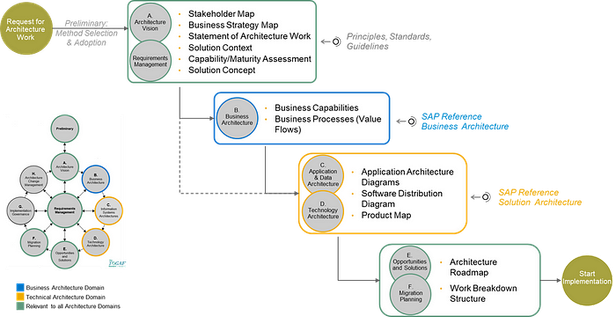
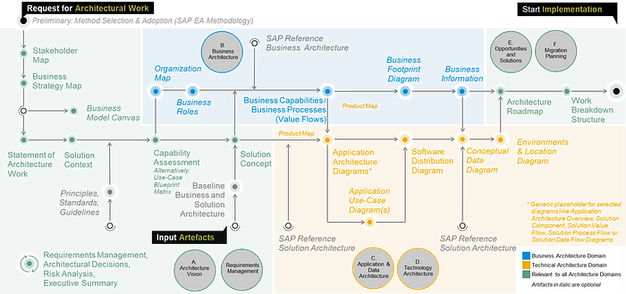
- SAP Reference Business Architecture (RBA) is based on SAP’s 50 years of industry experience and is aligned with best practices and standards, such as APQC. It describes the scope and undertaking of any enterprise, in a business-centric and product-agnostic way (described further is this blog post)
- SAP Reference Solution Architecture (RSA) explores how SAP addresses a customer’s business challenge with its unique product portfolio (described further in this blog post)
The Reference Business Architecture and Reference Solution Architecture are structured alongside the following four architecture views: Capability View, Process View, Data View, and Organization View. The four views cover a business and IT related model and allow the navigation between these two perspectives.
SAP reference architecture provides an enormous value for Enterprise Architects since navigation between different views and respective entities adds significant value, as the content of the reference architecture is a SAP official and authored content
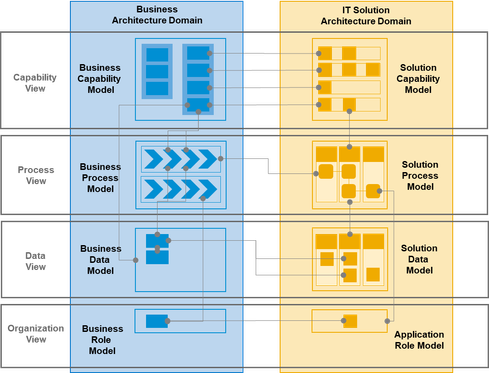
- SAP Signavio is used to describe all reference architecture and help navigate the RBA and RSA.
- LeanIX, recently acquired by SAP, will be a tool of choice for leveraging the SAP EA framework. Rene de Daniel created various video capsules demonstrating a first insights on how LeanIX EAM will feature the SAP Enterprise Architecture Framework.
- SAP Cloud ALM, an out-of-the-box, native cloud solution, designed as the central entry point to manage SAP landscape with content-driven guided implementation and highly automated operations.

SAP Signavio offers a set of tools bundled in a suite:





2. LeanIX for implementing the SAP EA framework
LeanIX strategy is to stay open (e.g. not being specialized for any ERP) and to support companies doing business an IT transformation.
It must be noted that LeanIX offers a deep integration with SAP Signavio for years. I suppose that the next step for SAP will be to facilitate the integration of the Signavio authored content in LeanIX for Enterprise architect to be able to design more precisely and more rapidly the target architecture (including integration with other applications in the company landscape). LeanIX will also be the home for the SAP EA framework. I have no doubt that all other EA tool vendor will implement the SAP EA framework when it will be finally released.
To have a glance of what it could look like, you can look at Rene de Daniel blog post.


3. SAP Cloud ALM for managing the end-to-end deployment lifecycle
SAP Cloud ALM is the “third stage of the rocket”, focusing on end-to-end application lifecycle (orchestration of all needed tasks).

- enables customers to adopt innovation at scale
- helps to keep the business running by protecting business continuity
- serves as anchor point and accelerator for customer transformations
is included in maintenance and subscription - replace SAP Solution Manager (7.2 mainstream maintenance ends Dec. 31, 2027)
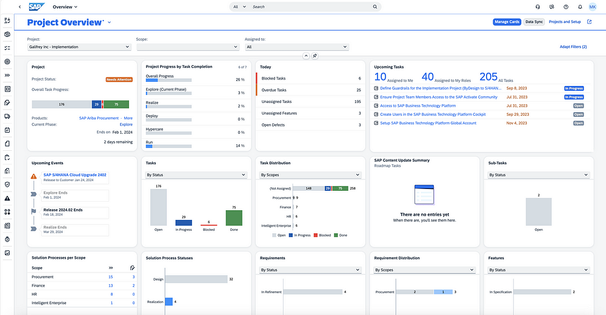
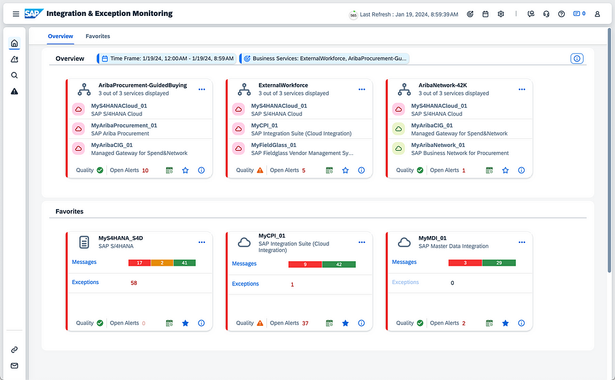

- SAP EA Framework Presentation at the TOGAF® Standard 10th Edition — Launch Event
- SAP Enterprise Architecture Framework by Rene de Daniel
- SAP enterprise Architecture framework — LeanIX exploratory work
- SAP Enterprise Architecture — Video Examples with LeanIX
- SAP Reference Architecture Content: An Overview
- AQPC Website
- SAP Enterprise Architecture discussion group
- SAP Signavio Process Explorer
- SAP Discovery center
- SAP Managed Tags:
- SAP Enterprise Architecture Designer
- Mark as New
- Bookmark
- Subscribe
- Mute
- Subscribe to RSS Feed
- Permalink
- Report Inappropriate Content
02-02-2024 2:49 PM
Wow, William, lots of good content about what is going on with the world of SAP EA's. Hopefully people will post the content or links to new content and learning here in the community site as it comes out. Keep us all posted!
SAP Canada
- SAP Managed Tags:
- SAP Enterprise Architecture Designer
- Mark as New
- Bookmark
- Subscribe
- Mute
- Subscribe to RSS Feed
- Permalink
- Report Inappropriate Content
02-04-2024 8:29 PM
William, This is an extensive blog with greth depth. Looking forward to the SAP Enterprise Architecture Forum in New Town Square and the European editions that follow. With LeanIX SAP finally has an EA tool that can call their own, and combined with Signavio it starts to complete the story.
Paul, Martin the EA community is growing. The early adoption of the groups platfrom can only help us grow faster.
- SAP Managed Tags:
- SAP Enterprise Architecture Designer